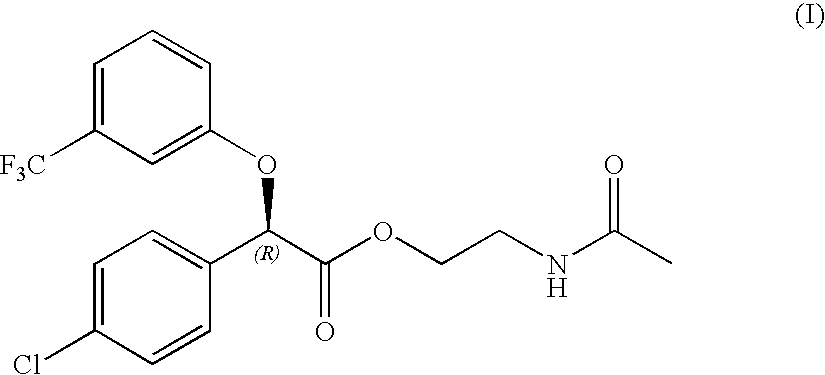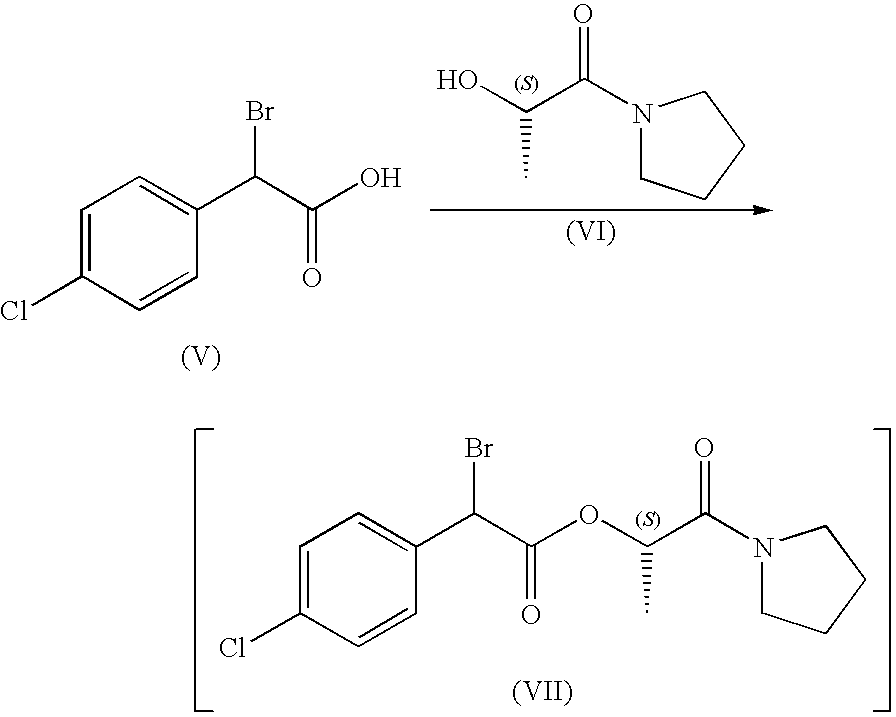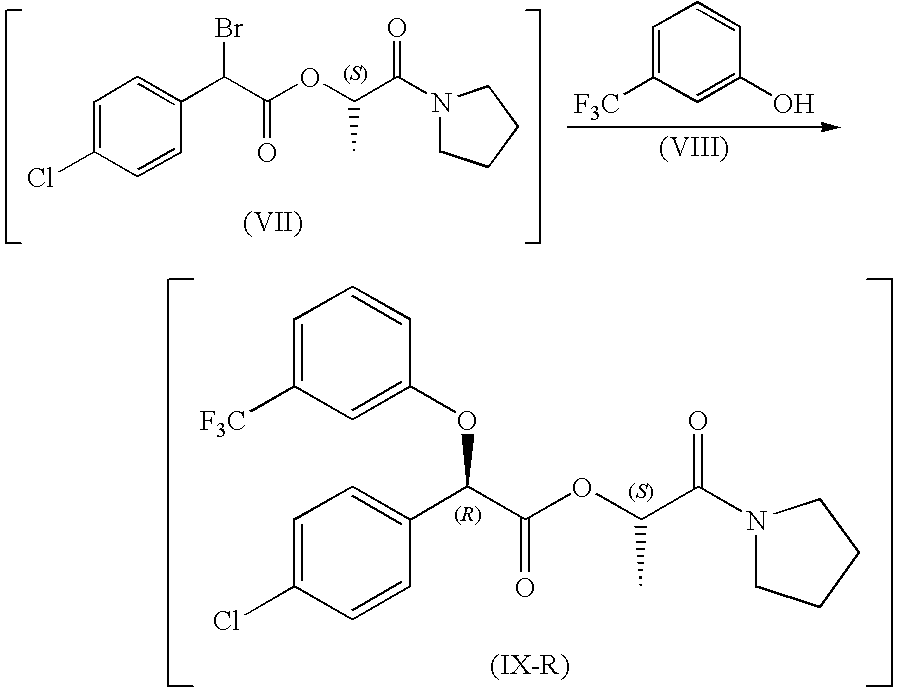Process for the preparation of (-)-(4-chloro-phenyl)-(3-trifluoromethyl-phenoxy)-acetic acid 2-acetylamino-ethyl ester
a technology of acetic acid and phenoxy, which is applied in the separation/purification of carboxylic acid amides, metabolism disorders, and drug compositions, etc., can solve the problems of impaired glucose tolerance, increased and premature mortality, and uncontrolled hyperglycemia, so as to improve hba1c, increase blood glucose levels, and improve hba1c.
- Summary
- Abstract
- Description
- Claims
- Application Information
AI Technical Summary
Benefits of technology
Problems solved by technology
Method used
Image
Examples
example 1
Preparation of (−)-(4-Chloro-phenyl)-(3-trifluoromethyl-phenoxy)-acetic acid
[0113]
STEP A:
[0114]DCC (42.18 g, 0.204 mol) was dissolved in toluene (50 mL) and stirred at room temperature. α-Bromo-4-chlorophenylacetic acid (50.00 g, 0.200 mol) toluene (50 mL) and (S)-N,N-tetramethylene-lactamide (29.27 g, 0.204 mol) were placed into a 500 mL flask. The resulting yellow solution was then cooled to 0° C. To the solution was added DMAP (25.5 mg, 0.0002 mol) and then dropwise, at 0° C. the prepared DCC in toluene solution. The resulting suspension was stirred at 0° C. for 3 hours, then at room temperature for 6 hours. Dicyclohexylurea (prepared as a byproduct) was filtered off and washed with toluene (100 mL). The filtrate (containing the desired product, bromo-(4-chloro-phenyl)-acetic acid 1-(S)-methyl-2-oxo-2-pyrrolidin-1-yl-ethyl ester) was then transferred to a 1 L reactor for the next step.
STEP B: Preparation of Lithium-Phenolate Solution
[0115]LiOH.H2O (9.35 g, 0.228 mol) was suspende...
example 2
Preparation of (−)-(4-Chloro-phenyl)-(R)-(3-trifluoromethyl-phenoxy)-acetic acid 2-acetylamino-ethyl ester
[0119]
[0120](−)-(4-Chloro-phenyl)-(3-trifluoromethyl-phenoxy)-acetic acid (80.0 g, 242 mmol) was dissolved in toluene (485 mL) and the resulting mixture heated to 75° C. To the mixture was then added thionyl chloride (40.4 g, 340 mmol) over about 3 hours. The resulting solution was then heated to 95° C. for an additional 3 hours. The temperature of the resulting mixture was then adjusted to 70° C. and any excess thionyl chloride and some toluene removed by distillation. The resulting mixture was cooled to 0° C. and N-acethylethanolamine (38.7 g, 375 mmol) in DMA (32 mL) was added, at 0° C. over about 20 minutes. The resulting biphasic mixture was stirred at 0° C. for 60 minutes. The reaction was then quenched with water (80 mL) and an additional portion of toluene (210 mL) added. The resulting mixture was heated to 40° C., and the phases separated. The organic phase was washed 3...
example 3
Recrystallization of (−)-(4-Chloro-phenyl)-(3-trifluoromethyl-phenoxy)-acetic acid 2-acetylamino-ethyl ester
[0122]
[0123](−)-(4-Chloro-phenyl)-(3-trifluoromethyl-phenoxy)-acetic acid (90.0 g) was dissolved in diisopropylether (900 mL) at 55° C. The resulting mixture was polish filtered, the solution cooled to 44° C. over about 20 minutes and seeded. The resulting mixture was stirred for 1 hour at 44° C., cooled to 35° C. over 4 hours, then stirred at 35° C. for 2 hours to yield a thick suspension. The suspension was cooled to −5° C. over about 5 hours and then stirred at −5° C. The resulting crystals were filtered off with a centrifuge and washed with precooled (−5° C.) diisopropylether (100 mL). The wet product was dried at 30° C. to yield the title compound as a white crystalline solid, more specifically as white crystals, needles.
[0124]% ee>99.9%; chemical purity 99.9%
PUM
| Property | Measurement | Unit |
|---|---|---|
| temperature | aaaaa | aaaaa |
| temperature | aaaaa | aaaaa |
| temperature | aaaaa | aaaaa |
Abstract
Description
Claims
Application Information
 Login to view more
Login to view more - R&D Engineer
- R&D Manager
- IP Professional
- Industry Leading Data Capabilities
- Powerful AI technology
- Patent DNA Extraction
Browse by: Latest US Patents, China's latest patents, Technical Efficacy Thesaurus, Application Domain, Technology Topic.
© 2024 PatSnap. All rights reserved.Legal|Privacy policy|Modern Slavery Act Transparency Statement|Sitemap



